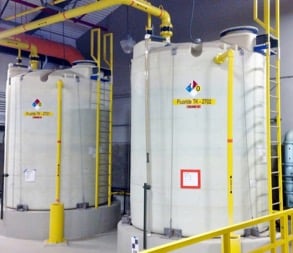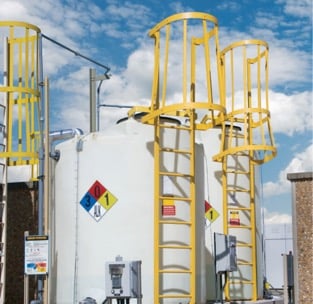Chemical Storage Tank Ladders
In some chemical storage tank applications, it is necessary to install a ladder to allow for inspection, to check gauges, and to service level sensors or mixers. In this blog we will discuss the various ladder options available, as well as which ladder system is best for your storage application.

Materials Used for Ladders
What a ladder is made of is one of the most important factors, especially if the tank is in a containment area and there is a risk of spillover. There are different materials available to ensure chemical resistance.
The most popular choices include:
- Fiberglass reinforced plastic (FRP) is a popular choice because of price and its compatibility with a number of different chemicals.
- Mild steel is another popular material. It can be coated with a direct-to-metal enamel, powder coated, galvanized or epoxy coated, depending on the chemical safety requirements.
Tank Ladder Sizes
 Poly Processing’s tank ladders can meet OSHA requirements and are available in heights from 6 to 20 feet, depending on the tank application. To determine the approximate height of the ladder required use the tank height measurement and round it to the nearest foot. Poly Processing Company will quote the specific ladder that is required for your application. The height of the tank is another consideration when choosing ladders. The smallest standard ladder offered by Poly Processing is 6 feet. Tanks with a center manway will have the additional cost of a platform to reach the manway.
Poly Processing’s tank ladders can meet OSHA requirements and are available in heights from 6 to 20 feet, depending on the tank application. To determine the approximate height of the ladder required use the tank height measurement and round it to the nearest foot. Poly Processing Company will quote the specific ladder that is required for your application. The height of the tank is another consideration when choosing ladders. The smallest standard ladder offered by Poly Processing is 6 feet. Tanks with a center manway will have the additional cost of a platform to reach the manway.
Poly Processing can also supply a free-standing ladder if the tank is too short or too small.
Make Your Ladder Safer
 Many ladder safety add-ons are required by OSHA depending on specific requirements. We strive to meet the requests of all customers when it comes to safety including those of OSHA or the local governing safety body.
Many ladder safety add-ons are required by OSHA depending on specific requirements. We strive to meet the requests of all customers when it comes to safety including those of OSHA or the local governing safety body.
These ladder safety options, often requested by customers at an engineer’s recommendation, include:
-
Cages - Ladders can be equipped with cages that act as safety barriers which provide fall protection. If someone falls, the cage can help catch them. Per OSHA requirements, the cages cannot extend less than 7 feet or more than 8 feet from the base of the ladder. This eliminates the possibility of someone hitting their head on the cage while walking under it. Cages range from 7 to 8 feet and extend 4 feet above the top rung of the ladder.
-
Fall Protection Systems - Ladders can also be equipped with a protection system that is comprised of a harness that connects to a lanyard. The lanyard is attached to a brake so that the harnessed worker can stop mid-fall. This option is not as popular as the cage, since there is maintenance involved with upkeep of the brake, lanyard and harness. This maintenance must be performed to stay in OSHA compliance. Even if OSHA does not require the protection system, if it is employed it has to meet standards.
Placement of Ladders and Other Features
OSHA in most cases requires a two-point attachment system for ladders - one at the top and one at the bottom. Many of Poly Processing’s tanks have molded-in attachment points for bolting in ladders on most of the vertical tanks we manufacture. The ladders are designed to attach at the manway, so that workers can climb up and inspect the inside of the tank. Poly Processing strongly prohibits anyone from getting on the dome of the tank. Polyethylene tanks are not designed for a live load or for a person to stand or walk on the dome (as plastic is slippery and could give some and create a trip hazard), so it’s normally not necessary to have a ladder that reaches the very top of the tank.
However, in some circumstances, personnel might need to reach gauges to read them, or they might need to reach the top of the tank to perform maintenance on level sensors or mixers. In these cases, either a special curved bracket will be needed to attach the ladder in the appropriate spot, or a second ladder can be installed where access to level sensors or other accessories is needed.
Other Considerations in Choosing Ladders
In situations where ladders are required in order to do work on the tank, they can be equipped with a 2’ x 2’ platform so that workers can stand on ladders for longer duration without balancing on the rungs.
Poly Processing Company can supply ladders for many of the tanks we manufacture. However, it is the responsibility of the end user to make sure the ladders are designed, installed, and used properly, and that they meet the requirements of the local, state, and federal safety laws and guidelines. These laws and guidelines are location specific and must be adhered to for the safety of personnel.
Learn more about safe ladder design by downloading our guide today.
- April 25, 2022
- Topics: Fittings and Accessories
About Poly Processing
Posts By Topic
Tech Talk Podcast Episodes
Subscribe By Email
Recent Posts
- Installation Tips for Chemical Storage Tanks: Site Preparation and Offloading
- Understanding pH and Chemical Concentration When Choosing a Chemical Tank
- Maximizing Fill Efficiency: Selecting the Optimal Fill Line System
- Chemical Storage Tanks: A Quick Guide for End Users
- Popular Customization Options for Chemical Storage Tanks
Tank Configurator

Find the recommended tank and system components for your chemical storage challenge.
Configure a Tank Package


